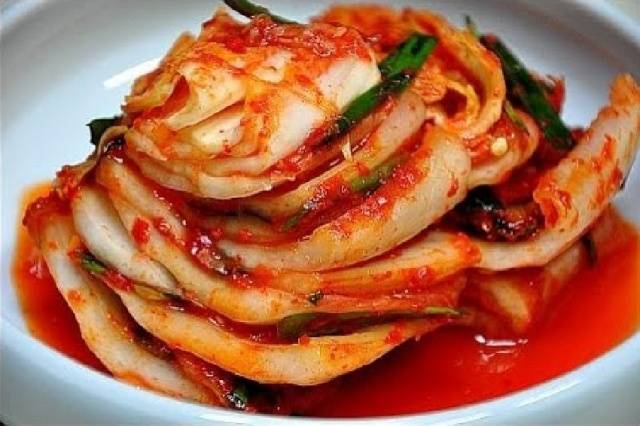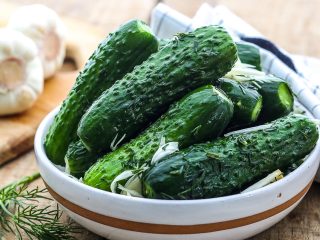Content
Chinese cabbage Not so long ago it became popular in preparations. Only now it can be freely purchased at the market or in a store, so there are no problems with raw materials. Many did not know about the beneficial properties of cabbage, because the main growing region was the countries of the East - China, Korea, Japan. In appearance, Chinese cabbage resembles a salad.
It is called “salad”. In terms of juiciness, it is the leader among all representatives of cabbage and salads. The white part contains the most juice, so you should not use only the leaves. The second advantage of Beijing salad is the absence of the “cabbage” smell, so familiar to many housewives.
Currently, borscht, salads, cabbage rolls, pickles and marinated dishes are prepared from Beijing. Lovers of healthy vegetables especially like kimchi, a Korean salad. Or, as they also say, Korean salad. This is a favorite delicacy among Koreans and all lovers of spicy dishes. Korean doctors believe that the amount of vitamins in kimchi is greater than in fresh Chinese cabbage due to the juice released. Methods for preparing Beijing korean cabbage some. After all, once on the table of our housewives, any dish undergoes changes.Let's look at the most popular recipes for delicious Korean marinated cabbage.
Preparing the necessary components for a simple version
To prepare Chinese cabbage in Korean, we will need:
- 3 kg of heads of Chinese cabbage;
- 1 pod of hot pepper;
- 3 peeled garlic heads;
- 200 g each of table salt and granulated sugar.
Some recipes contain different amounts of salt and sugar, so try to focus on your taste or prepare a little salad to determine its taste.
We choose heads of ripe Beijing cabbage. We will need ones that are not very white, but also not quite green. It's better to take the average ones.
We remove ripe Beijing cabbage from the top leaves (if they are spoiled), wash them, and let the water drain. The size of the heads of cabbage determines how many pieces we will have to cut them into. We cut small ones lengthwise into 2 parts, larger ones into 4 parts.
Grind hot peppers and garlic in a convenient way. Pepper can be either fresh or dried.
Mix vegetables with table salt and granulated sugar until smooth.
Now rub the cabbage leaves with this mixture, fold quarters layers into a pan and place oppression on top.
Pickling Korean-style Chinese cabbage This recipe will last 10 hours. After the time has passed, cut the quarters into pieces and serve.
There are recipes with some variations for better salting of Chinese juicy cabbage. For example:
- After the water has drained, fan out the Pekin cabbage leaves and rub each one with table salt. To make salting more even, dip the quarters in water, shake off excess moisture and then rub.
- Place tightly in a pickling container and leave in the room for a day. In this case, we do not compact the Beijing juicy cabbage.
- After a day, we wash the quarters and prepare a paste consisting of chopped garlic and hot pepper.
- Rub the Chinese cabbage leaves with the spicy mixture.
We put the cabbage in a container again, but this time for storage. We keep it warm for the first day, then place it in a cool place.
When serving, you will have to cut the leaves, so some people immediately cut the cabbage smaller and simply mix it with spices.
Both options are very spicy snacks. If you need to soften the dish, then reduce the amount of garlic and pepper in the recipe.
Salted Chinese cabbage
Salted Chinese cabbage acquires a piquant taste, and the addition of hot pepper makes the dish spicy. Therefore, recipes for salty Peking are very common among lovers of winter cabbage dishes. Let's look at some of them.
Spicy with bell pepper
In this version, almost all types of pepper are used - sweet, hot and ground. In addition there are spices - coriander, ginger, garlic. Spices, like hot peppers, can be taken fresh or dried.
Salted cabbage from Beijing with pepper is prepared from the following ingredients:
- 1.5 kg of heads of Chinese cabbage;
- 0.5 kg table salt;
- 2 pods of hot pepper;
- 150 g sweet pepper;
- 2 g ground pepper;
- 1 tablespoon each of chopped ginger root and coriander seeds;
- 1 medium head of garlic.
Let's start pickling Beijing juicy cabbage in Korean.
We are preparing a head of cabbage. Let's break it down into separate sheets. If some of them break, there is no need to be too upset.
To properly disassemble the cabbage, cut the head of cabbage into 4 parts.
Then we cut at the base and separate the leaves. It is not necessary to tear them off; you can simply move them away from the stalk.
Rub each leaf with salt and leave to salt for 6-12 hours. Periodically turn the leaves and re-coat them with salt. It is convenient to do this procedure in the evening so that the cabbage leaves are salted by morning.
After the allotted time, we rinse the Peking from excess salt. The leaves have already been taken as much as needed, and the rest needs to be washed off.
Now we don’t need the stalk; we perform further actions only with the leaves.
Prepare the ingredients for the spice. Ginger root, garlic, hot pepper will have to be chopped as conveniently as possible - on a fine grater, garlic press or in another way.
We clean the sweet pepper from the seeds and also grind it in a meat grinder or in a blender.
Stir and add a little water if the mixture is too dry. We will need to spread it on the leaves of Chinese cabbage.
Make the consistency convenient and coat each leaf of the Beijing vegetable on both sides.
Immediately place the leaves in a storage container. This can be a glass jar or container with a tight lid.
Leave in a warm room so that the seasoning is well absorbed.
After 3-5 hours we put it away for permanent storage, preferably in the refrigerator. We did not sterilize this workpiece. The composition of the spicy ingredients allows it to be stored in a cool place for 2-3 months.
This option for salting Beijing juicy cabbage involves a creative approach to the composition of the seasoning. You can add vegetables, herbs or your signature spices.
Your appetizer is ready, although the salty Beijing salad korean cabbage Goes great with side dishes too.
Pickles from Beijing
Let's get acquainted with some varieties of delicious Beijing cabbage preparations, the recipes of which have received recognition from housewives.
Chamcha
A famous Korean dish made from Beijing juicy cabbage. Requires time to prepare, but not effort. For a qualitative result, let’s take:
- 2 liters of water;
- 3 tablespoons table salt;
- 1 head of pekinka;
- 4 things. hot pepper;
- 1 head of garlic.
We make the brine. Boil water and dissolve salt in it.
We clean the head of Beijing lettuce from spoiled leaves, if any, and cut it into 4 equal parts.
Place the quarters in salt water.
Leave in a warm place for a day to salt out.
Grind the pepper and garlic, mix, dilute slightly with water to the consistency of sour cream.
Place in the refrigerator for a day.
After a day, we take the pekinka out of the brine, wash it and coat the leaves with a hot mixture.
Adding chopped vegetables to the mixture to your taste will help reduce the spiciness of Chinese cabbage-chamcha.
Kimchi
This recipe uses spices. The main ingredients remain in the same composition and quantity, only ginger root, soy sauce, coriander seeds and a dry mixture of peppers (you can buy ready-made) are added to them. Let's break the cooking process into three stages and get started.
Stage one.
We immerse chopped Chinese cabbage in boiling brine, having previously cleared it of the top leaves and stalks. Remove from heat and press gently with pressure.To do this, you can take a plate, turn it upside down and weigh it down with a three-liter jar of water. After the brine has cooled, remove the pressure. We do not remove the plate; it will protect the Chinese cabbage from dust during salting. Salting time – 2 days.
Stage two.
Prepare a spicy paste from the remaining ingredients. We don’t do this procedure in advance, but start before putting the Peking into the jars. Grind all components with a blender or meat grinder. The only exception is sweet pepper, cut into strips. Soy sauce in the recipe serves as a substitute for water and salt.
Stage three.
Wash the cabbage after brining, grease it with paste, mix it with bell pepper and put it in jars. Fill the remaining space with brine. We close the jars with lids and leave them in the room.
As soon as air bubbles appear on the walls of the dish, move the workpiece to the refrigerator. Keep it cool.
Conclusion
If you carefully consider the listed options, the basis of the process remains the same throughout. The difference is only in small nuances. However, the taste of the dishes is different. Therefore, it’s worth trying each of them if spicy dishes are welcome in your family. To better understand the cooking technology, it’s good to watch a detailed video of the process:
Bon appetit!














